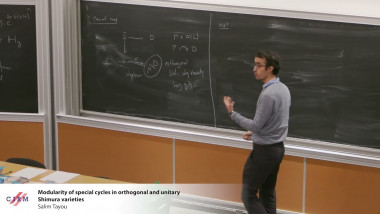
A $\lambda$-adic family of Funke-Millson cycles and a $\lambda$-adic Funke-Millson lift
By Paul Kiefer

Modularity of special cycles in orthogonal and unitary Shimura varieties
By Salim Tayou
Appears in collections : Jean-Morlet Chair: Relative trace formula, periods, L-functions and harmonic analysis / Chaire Jean-Morlet : Formule des traces relatives, périodes, fonctions L et analyse harmonique, Exposés de recherche
A thousand years old problem is to determine when a square free integer $n$ is a congruent number ,i,e, the areas of right angled triangles with sides of rational lengths. This problem has a some beautiful connection with the BSD conjecture for elliptic curves $E_n : ny^2 = x^3 - x$. In fact by BSD, all $n= 5, 6, 7$ mod $8$ should be congruent numbers, and most of $n=1, 2, 3$ mod $8$ should not be congruent numbers. Recently, Alex Smith has proved that at least 41.9% of $n=1,2,3$ satisfy (refined) BSD in rank $0$, and at least 55.9% of $n=5,6,7$ mod $8$ satisfy (weak) BSD in rank $1$. This implies in particular that at last 41.9% of $n=1,2,3$ mod $8$ are not congruent numbers, and 55.9% of $n=5, 6, 7$ mod $8$ are congruent numbers. I will explain the ingredients used in Smith's proof: including the classical work of Heath-Brown and Monsky on the distribution F_2 rank of Selmer group of E_n, the complex formula for central value and derivative of L-fucntions of Waldspurger and Gross-Zagier and their extension by Yuan-Zhang-Zhang, and their mod 2 version by Tian-Yuan-Zhang.
